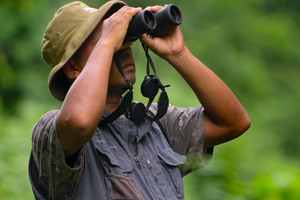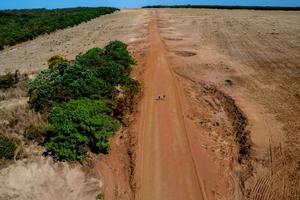Finding alternatives to conventional charcoal is key to preserving the Congo’s forests, wildlife, and environment.
Finding alternatives to conventional charcoal is thus key to preserving Virunga’s — and the Congo’s — forests, wildlife, and environment, as well as to boosting the local economy. Several local and international groups are working to achieve that goal. These initiatives include making charcoal in a more sustainable way by cultivating tree plantations, introducing better production techniques, and supplying more efficient cookstoves. A plan to harness small hydropower aims to reduce dependence on charcoal by supplying clean electricity for cooking.
Without these efforts, Virunga’s forest remains in peril. Emmanuel de Merode, director of Virunga, has called charcoal the biggest threat to the park. While driving on the outskirts of Virunga, Thierry Lusenge, sustainable energy program manager at the World Wildlife Fund (WWF) in Goma, pointed to a barren field spanning miles. “This used to be forest,” Lusenge observed. To satisfy demand for wood and charcoal, he said, “now people are going inside Virunga.”
Like so many of sub-Saharan Africa’s environmental problems, the felling of trees for charcoal in Virunga is partially the result of swelling populations in need of energy. The population of Goma, the capital city of North Kivu province, has increased from 150,000 in 1990 to more than 1 million today. (In that time, the population of the Democratic Republic of the Congo has more than doubled, from 35 million to 79 million.) The African Conservation Fund estimated that in 2008, Goma’s residents were burning about 59,000 tons of charcoal annually. Now, consumption has doubled to 116,000 tons a year, according to WWF.
Virunga covers an area double the size of the state of Rhode Island and is difficult to patrol. With a host of other problems, including life-threatening attacks from rebel groups, stopping the majority of the population from using charcoal has proven to be unrealistic. The park’s guards — 160 of whom have lost their lives in more than a decade of civil strife in eastern Congo — are often focused on higher priorities, such as protecting the endangered population of mountain gorillas.
The $35 million underground charcoal business helps fund rebel militia groups that operate in Virunga.
The illegal trade in charcoal not only threatens the environment. The $35 million underground business helps fund rebel militia groups that operate in Virunga, exploit its resources, and terrorize locals. Since 1996, the region has been wracked by conflict involving Congolese forces, anti-government rebels, and militia from Rwanda and Uganda. Approximately 5.6 million people have died in eastern Congo, victims of the deadliest conflict since World War II.
“Virunga faces a number of threats, including poaching and oil exploration, but the illegal charcoal trade is uniquely damaging,” according to the Enough Project, a non-profit in Washington D.C. that fights genocide and mass violence in Africa’s combat zones. The U.S. State Department has described charcoal as “’the most important single threat to the park’s long-term sustainability.”
A tree farmer in eastern Congo stacks wood in a way that allows better air circulation during charcoal production, helping to carbonize wood more quickly and efficiently. Amy Yee/Yale e360
In 2007, WWF started a sustainable charcoal program in the region, with support from the European Union and the Netherlands, as well as help from local community groups. The initiative trained farmers to cultivate fast-growing trees such as eucalyptus. WWF grew tens of thousands of seedlings and distributed them free to farmers to grow on plantations. As of 2015, more than 21 million trees had been planted around the park, according to WWF. In the next few years, 22,000 acres of reforested land could supply up to 20 percent of Goma’s annual charcoal demand.
One farmer named Maoneo Shabapiuku said he used to freely fell trees, especially hardwood species. After training through the program, he now grows seedlings on a small plantation and avoids overcrowding his small plots. WWF field staff and local community organization partners conduct checks to make sure farmers are following instructions in order to maximize tree growth. After four to five years, farmers can cut trees to make “eco-charcoal.”
WWF has trained more than 9,300 small farmers to produce charcoal using these techniques, which carbonize wood more quickly and efficiently by stacking it in a way that allows better air circulation in its center. Bahati Bahobwerhe has been making charcoal for 26 years. Before, he would burn wood in a dirt-covered pit for one week. “There was a lot of waste in the old method,” he said. He estimated he made seven bags of charcoal per week using the old method. Using the new method, he makes 26.
Tree plantations provide regular incomes for small farmers who eke out scarcely $100 a month growing cassava, banana, and other crops. “People want to survive,” explained Lusenge of WWF. “They want money to help with sending their children to school.”
But the eco-charcoal program faces obstacles, including lack of knowledge about local tree-growing and poor land management. The supply chain and market for eco-charcoal are nascent. And it’s difficult to teach entrepreneurship to farmers in a region ravaged by violence for more than two decades.
A shop in Goma sells efficient cookstoves that burn half the fuel used in conventional models. Some 76,000 efficient cookstoves are now in use in North Kivu province. Amy Yee/Yale e360
In conjunction with the charcoal program, WWF is teaching locals, including many women, how to make and sell efficient cook stoves using widely avaialable materials like clay and sheet metal. The stoves burn half the amount of fuel used in conventional models. Some 76,000 are in use so far in North Kivu. WWF estimates efficient cook stoves have saved about 60,000 tons of charcoal since 2010.
Adeline Kahindo Tsongo, 53, is head of a women’s group in Goma that makes stoves and sells them for about $1 each. That provides Tsongo with an income of up to $400 in a year, which pays for food, school fees, and other expenses. Three of Tsongo’s children are now in university.
The Virunga Alliance, a public-private affiliate of the national park, also has launched an effort to bring hydropower to the region to run electric cookstoves that will replace charcoal ones. The group is building micro-hydroelectric power plants — small “run-of-the-river” installations that do not require dams. To encourage people to cook with electricity rather than charcoal, the Virunga Alliance plans to give 12,000 free electric burners to rural families.
“We’re trying to slow down pressure on the land,” says one official.
Two micro-hydropower plants are already running, and there are at least two more planned. The first was a small pilot project funded by the European Union outside the park’s northwest border. The second is a much larger plant that can generate about 13 megawatts of electricity. It started operating in December 2015 after two years of construction in the southern town of Matebe. In a village near Matebe called Ruchiro, new public streetlights illuminate dirt roads at night. As of this spring, 3,000 households had paid to connect to Matebe’s electricity.
One village resident, Fifi Antoinette — who now has electricity — did not wait for her free electric burner from the Virunga Alliance. “I bought my own,” she said, displaying her sleek store-bought, two-burner cooktop.
Building and running a hydropower utility in a conflict zone infamous for corruption and poor governance is daunting. But, says Ephrem Balole, chief executive of Virunga Energy, the energy arm of Virunga Alliance, “Even if it’s very difficult, it’s another way of doing things. We’re trying to slow down pressure on land. By not doing anything now, how will you sustain the park’s future?”





